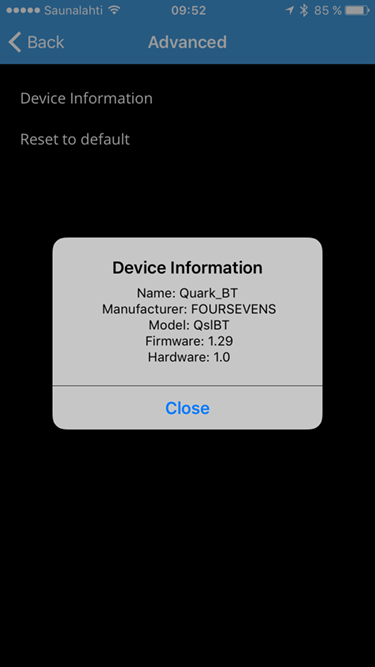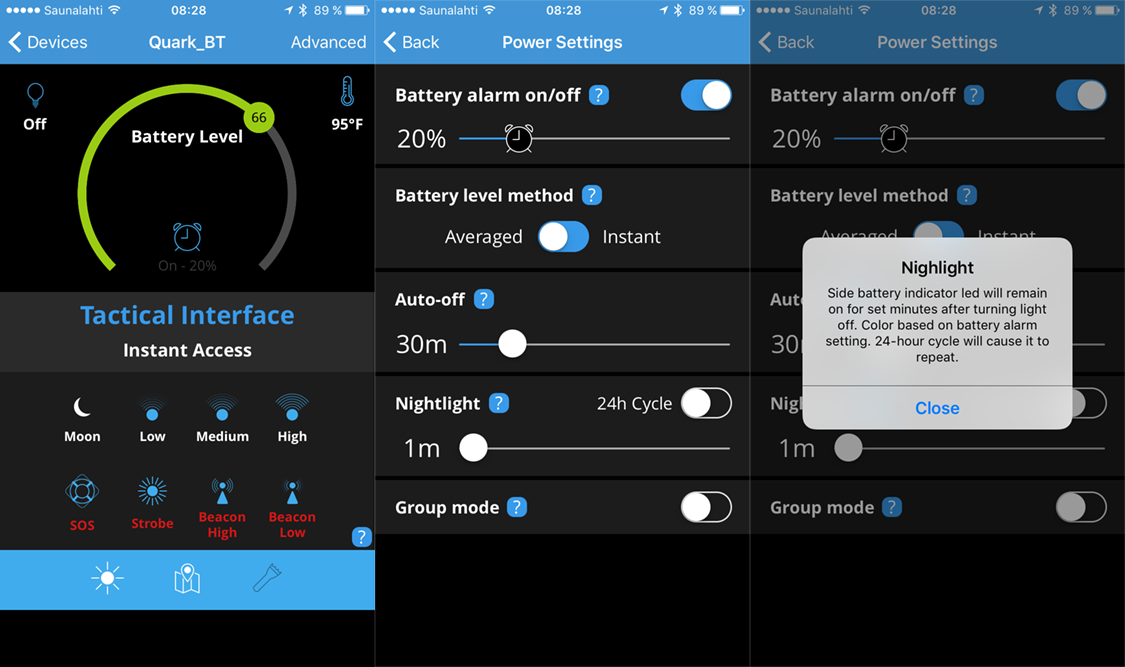Note: Review was done on the initial software revision. This review will be updated as the smart app matures.
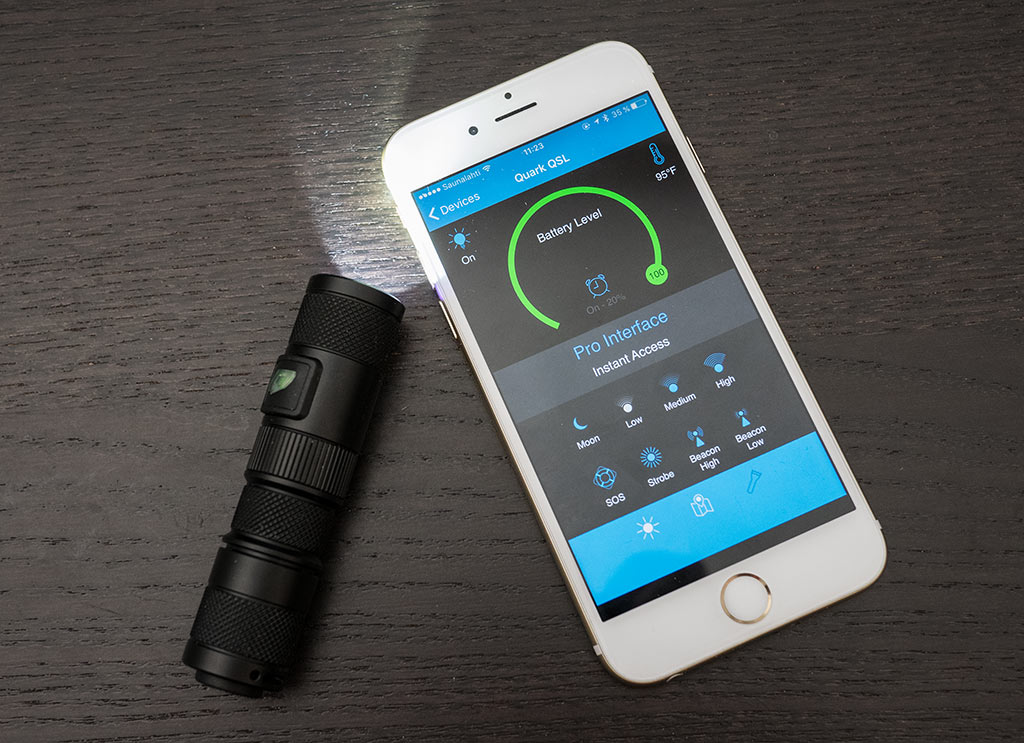
The Foursevens Quark Smart QSL-X is the world's first smartphone controlled flashlight. It houses a CR123A/RCR123 battery and an interesting software programmable double switch system.
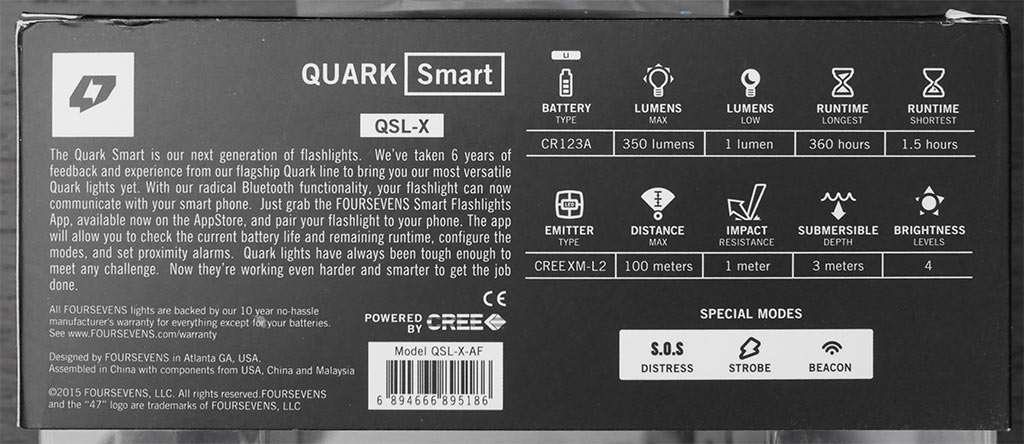
* Battery type: CR123A/RCR123/16340
* LED: Cree XM-L2
* Color temperature: Not specified
* Body material: Type-III hard-anodized aircraft-grade aluminum
* Reflector: Orange peel
* Lens: Glass, sapphire coaring, anti reflective
* Waterproof: Not specified
* Impact resistance: Not specified
* Switch type: Side and tailcap
* Battery protection: Reverse polarity
* Regulation: Output regulation
* Tail stand: Yes
* Tripod threads: No
* USB rechargeable: No
* Controllable via Bluetooth 4.0LE from an iOS device (Android coming later)
* Length: 89,3 mm
* Width: 22 mm
* Head width: 23,1
* Weight: 42 g
* Output levels: 4
* Mode memory: Yes, programmable
* Button lock: No
* Direct access from off: Any mode with the smartphone app, strobe, moonlight, high
Special modes:
* Strobe (10 Hz)
* SOS
* Beacon Hi (1 sec momentary every 10 seconds)
* Beacon Lo (lower level 1 sec momentary every 10 seconds)
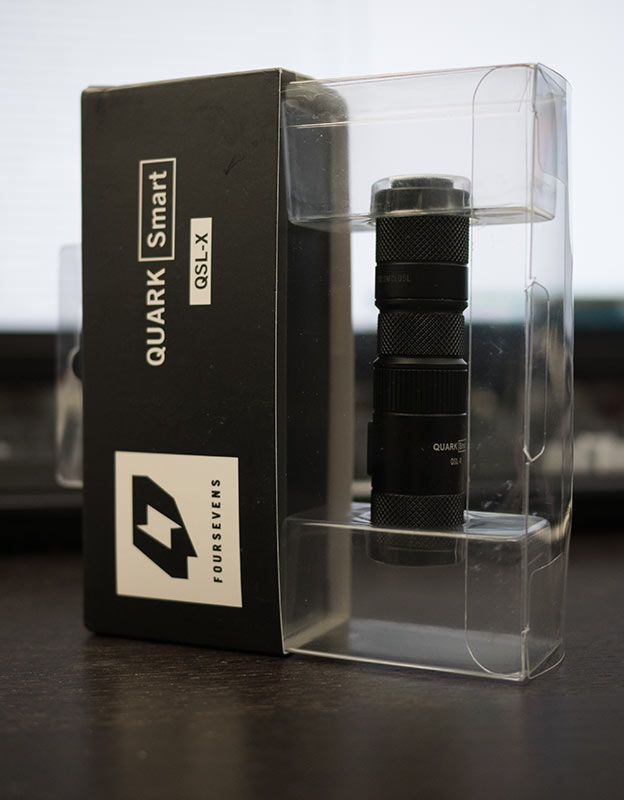
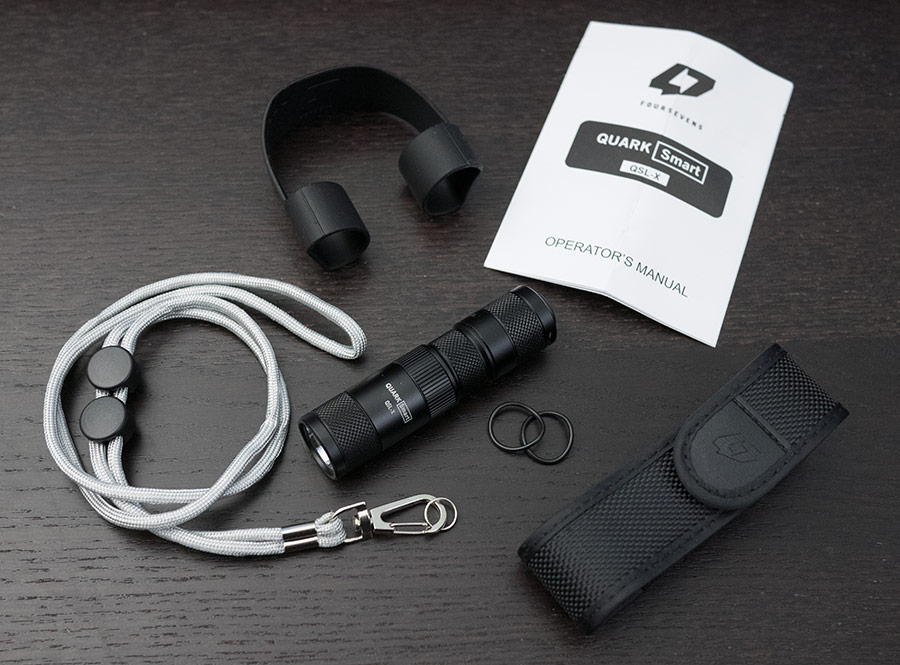
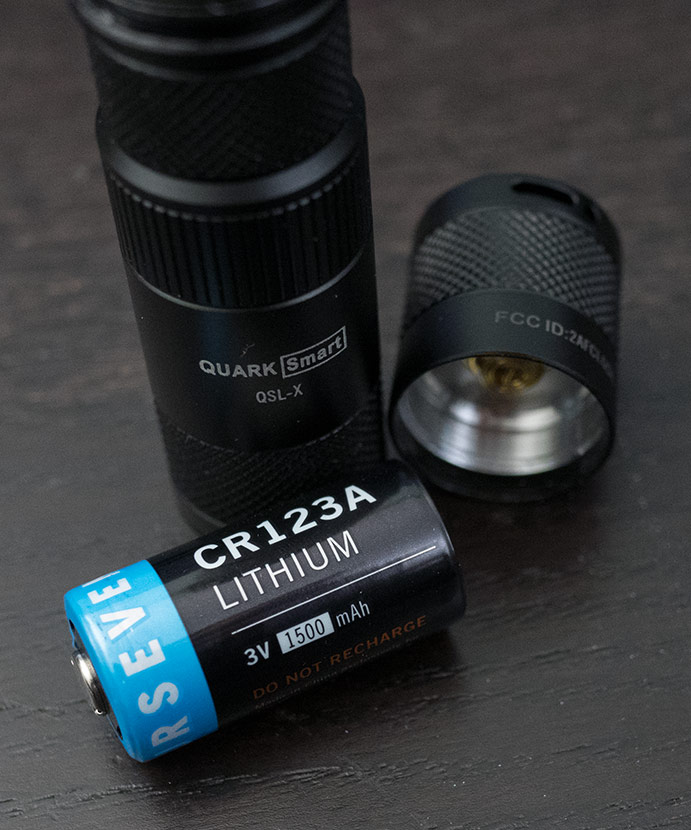
Included in the package
* Foursevens Quark Smart QSL flashlight
* CR123A battery
* Lanyard
* Keychain carabiner + ring
* Spare o-ring
* Holster
* Rubber finger-grip
* Operation guide
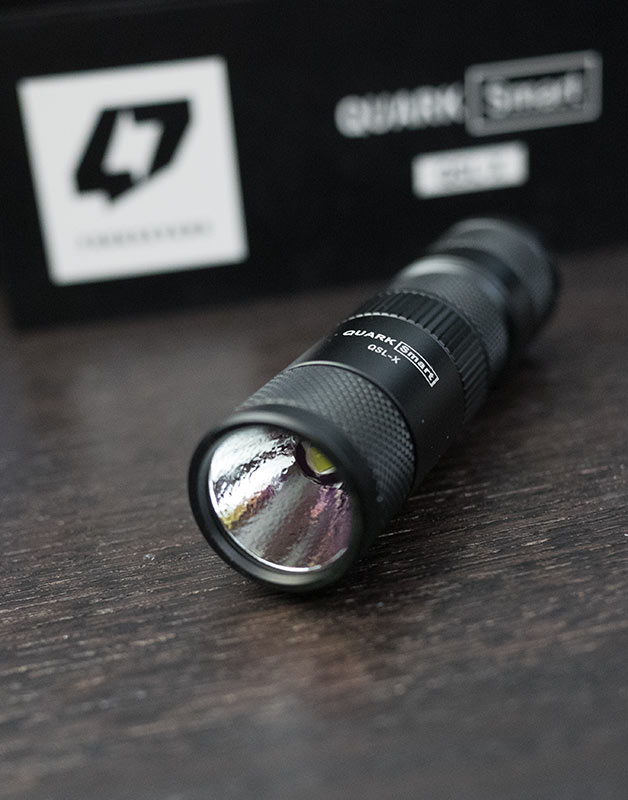
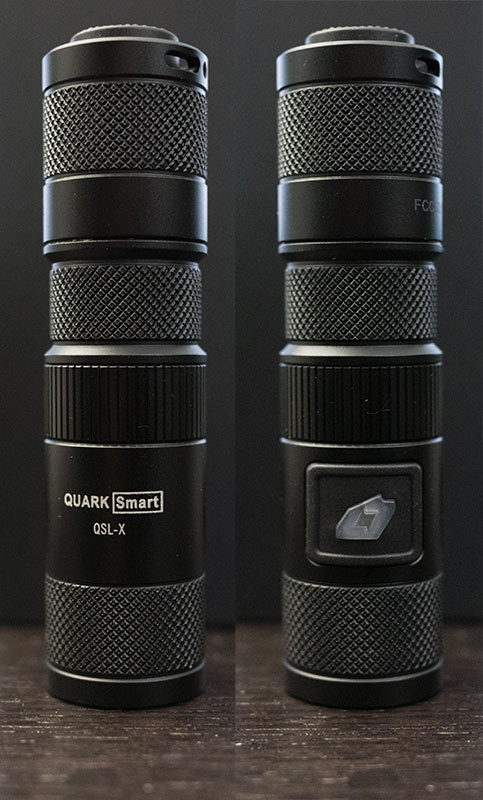
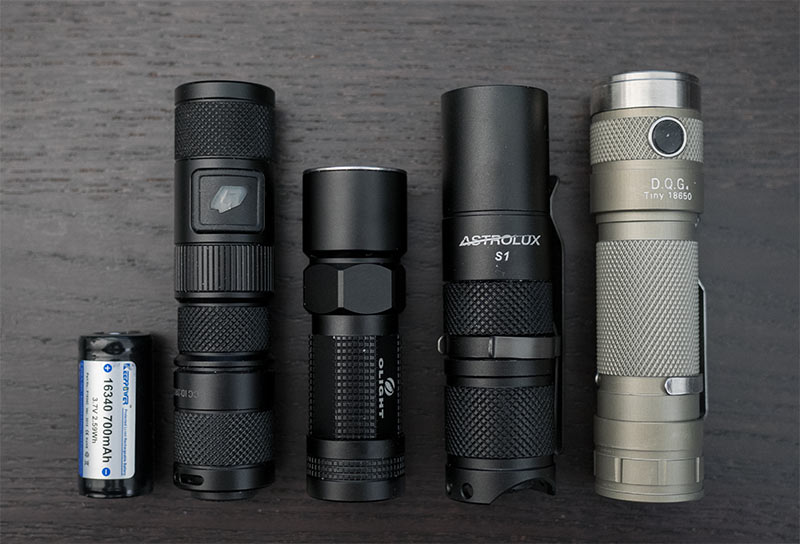
16340/RCR123A battery, Foursevens Quark Smart QSL-X, Olight S10, Astrolux S1 (18350), DQG Tiny 18650 4.
Bluetooth and smart features (will be updated when the app is patched)
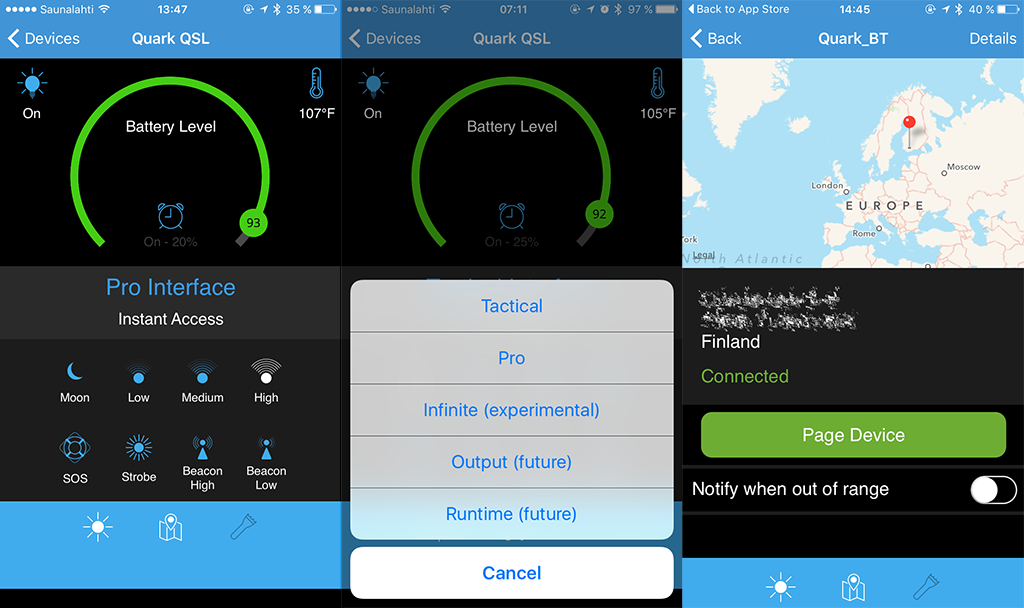
The distinctive feature of the Quark Smart series is the ability to control them via bluetooth. The bluetooth 4.0 low energy protocol has a miniscule current draw and doesn't affect the battery life at all in practice.
There's a lot of potential with the technology, but most of it is unrealized at the time of writing this. Some promised features are still missing, such as the remaining time indicator or timer mode where you tell the light how long it has to stay on and it automatically adjust the output level to match. These are coming though, as soon as Apple store verification process is finished.
Currently the only reasons to use the smart features are checking the battery level, changing the UI mode (Tactical/Pro), remotely powering the light up and checking the last known location if you have lost the light. The temperature indicator is only in Fahrenheit and seems to seldom update itself. Even after shutting off the light, the temperature indicator stayed at 118°F for many minutes. Maximum temp I measured from the head was 42°C (108°F).
I would also like to see unlimited mode programming features. Being able to program any number of modes with infinitely adjustable output levels straight from your phone and then saving presets of those would be great. Some other useful possibilities would be setting the double click from off shortcut to any desired mode (currently strobe) or swapping the functionality of the switches or disabling either switch completely.
Tactical and Pro modes
The Quark Smart QSL-X has two modes that make the flashlight act differently to button presses. The switch between these two modes requires the use of the smart app. Since Android is not supported yet, users of Android phones have to loan an iPhone or request the Pro mode be activated when ordering. The Tactical mode is active by default.
In tactical mode, the tailcap switch acts only as a momentary switch. Keep it pressed and it activates the last used mode. The light remembers the last mode (also special modes) with the siwde switch and the momentary tailcap switch. In pro mode, the light always starts on low and the tailcap switch activates high. To activate high from off double click and hold the side switch.
In the first retail lights, there is a problem where a short click is probably required to be too short. When you want to return to the last active mode from off, the click has to be very fast. A normal lazy press will almost certainly start the light on moonlight.
This affects other UI features too. After choosing a suitable output level first by holding the side switch from off and then double clicking the light does not always advance to the next brightness level but to the previous. Following double clicks then just cycle between these two modes or sometimes advance to the next mode. All of this depends on the speed of the clicks you do during the double clicking.
In the Pro Interface mode there is no mode memory, unless you turn the light back on after only a second or two. Both switches latch on: a single click turns the light on and off. Double click (both switches) or long press on the side switch cycles modes. Double click and hold from off cycles modes backwards.
Long press on the tailcap switch activates momentary high. After releasing the button it returns to the previous mode. Long press of the tailcap switch in off activates momentary high and turns the light off after releasing. Double click from off activates strobe.
All in all, the UI is complicated even when not using the smart phone app. The fact that there is no comprehensive manual for features, you have to go searching forum threads for info. This light is not meant for your average joe. There should be at least an electronic and always up to date manual inside the app.
The functionality of the tailcap switch is heavily affected by the battery size. If the length is not exactly right, some features will be buggy or not work at all. The tailcap switch on my sample didn't work with the supplied CR123A primary. It was probably just a bit too short, because it only worked when pressed forcefully. With a Keeppower 16340 I had to open the tailcap one turn, since it is longer than a regular CR123A.
The UI is complicated and you should watch David Chow's good videos on how the tactical and professional modes work. After some use, the Pro Interface will probably grow on you.
Measurements
Please note: lumen measurements are only rough estimates
My diy 30 cm integrating styrofoam sphere has been calibrated using a Fenix E05 on high with manufacturer's claim of 85 lumens. Verified with an Olight S10 that has been measured with a Labsphere FS2 integrating sphere by valostore.fi. Results may be more inaccurate with especially throwy or floody lights.
For spectral information and CRI calculations I have an X-rite i1Pro spectrophotometer with HCFR for the plot and ArgyllCMS spotread.exe for the data. For runtime tests I use spotread.exe with a custom script and a i1Display Pro because it doesn't require calibration every 30 minutes like the i1Pro.
Explanation of abbreviations
CCT = correlated color temperature, higher temperature means cooler (bluish)
CRI (Ra) = color rendering index consisting of 8 different colors (R1-R8), max value 100
CRI (R9) = color rendering index with deep red, usually difficult for led based light sources, max value 100
TLCI = television lighting consistency index, max value 100
CQS (Qa) = Proposed replacement for CRI, RMS average of 15 color samples
CRI2012 (Ra,2012) = Another proposed replacement for CRI, consists of 17 color samples
MCRI = Color rendering index based on the memory of colors or 9 familiar objects
x,y = coordinates on a CIE 1931 chart
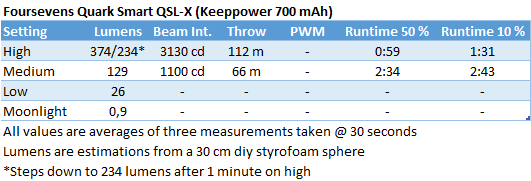
The lumen output exceeds the manufacturer's specification of 350 lumens. Low is off by a factor of 2,6 and medium is 29 % higher. Moonlight however is spot on.

Color rendering is a big disappointment. There's no mention of color temperature or CRI on the manufacturer's website, but the rep here on CPF promised an led with a CRI of 85. This is not the case, as you can see. This is your typical Cree XM-L2 with green tint and CRI in the 60s. CRI(R9) is the worst I've measured from a flashlight at -50.
Spectral distribution (High)
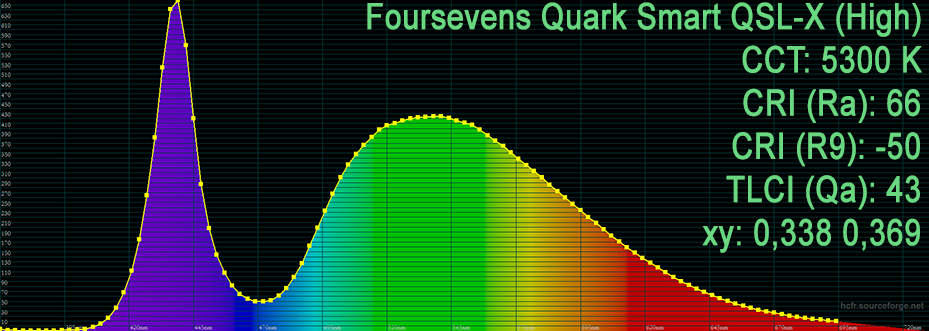
Color rendering (High)
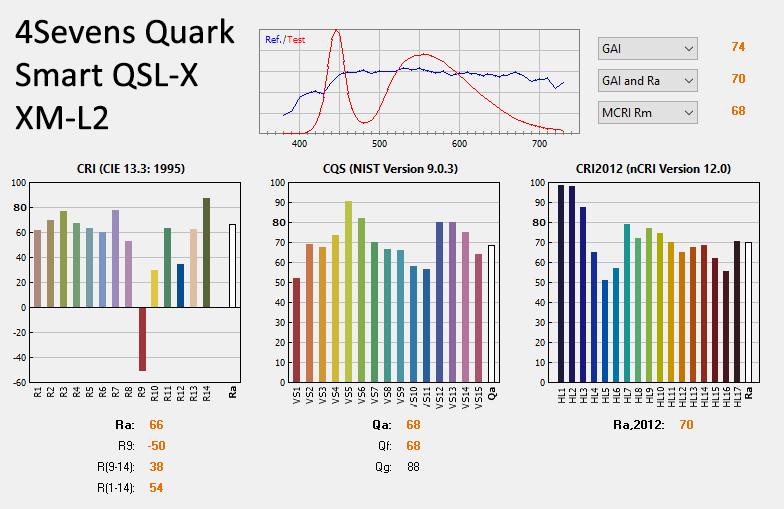
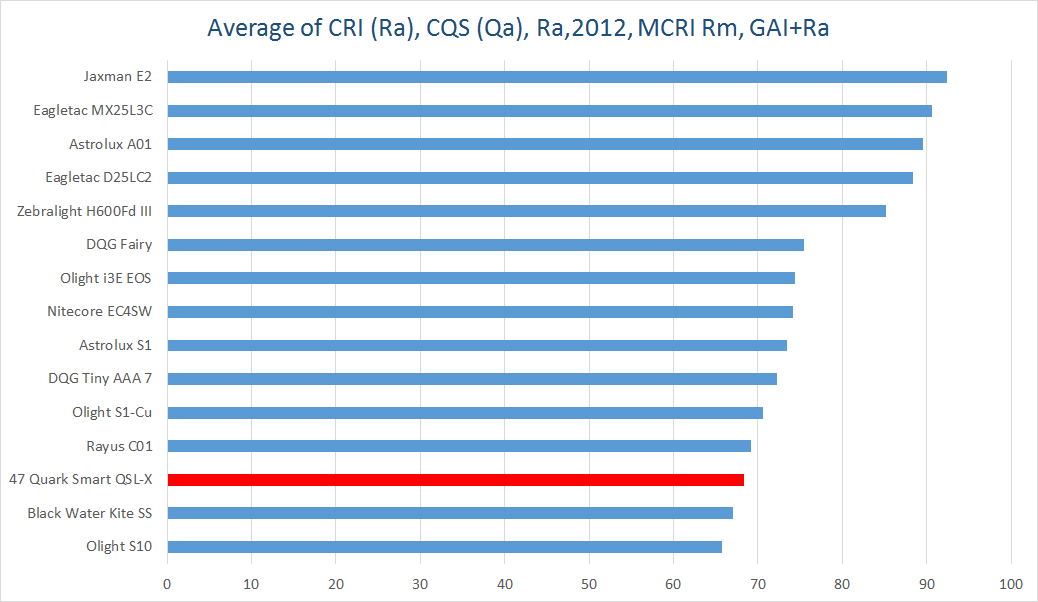
Beam and tint
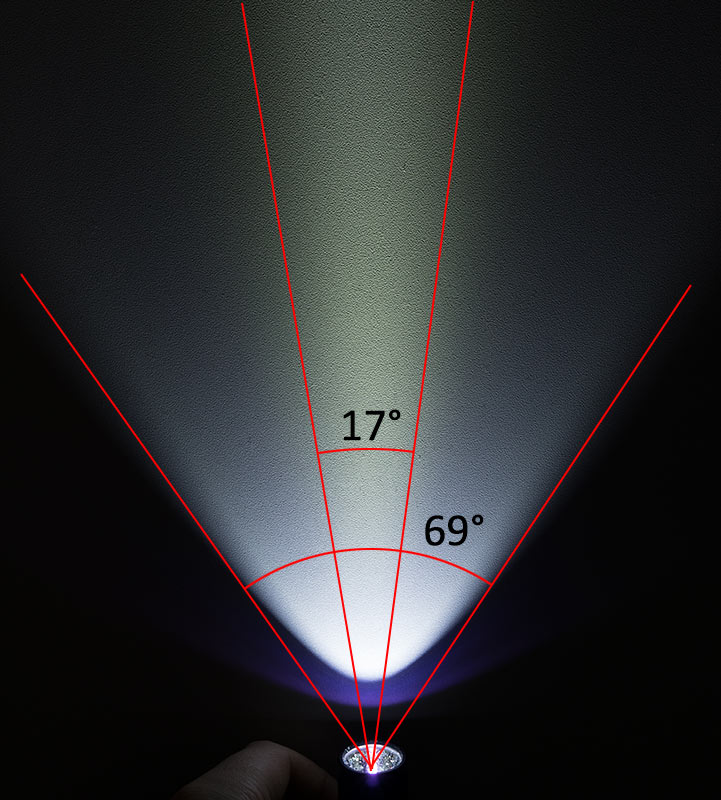
Beam has a hotspot angle of 17° and spill of 69°.
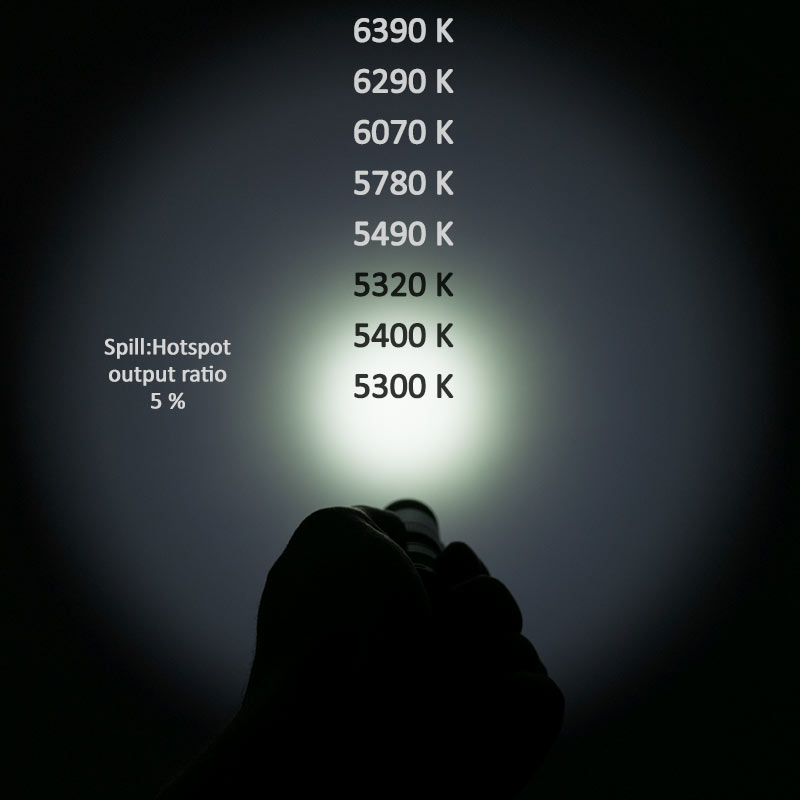
Average spill brightness is 5 % of the hotspot.
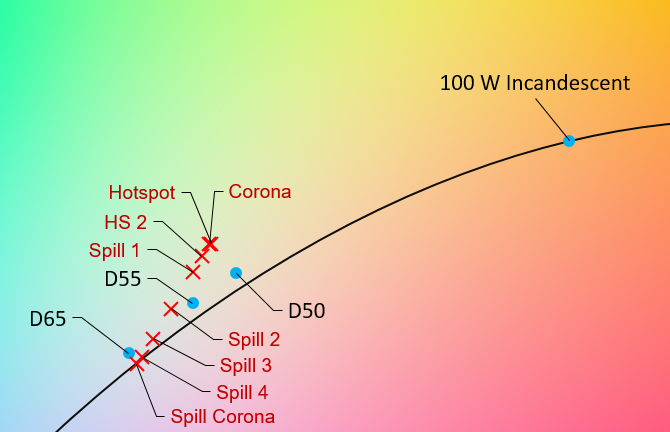
The tint has a clear but linear shift on different areas of the beam.
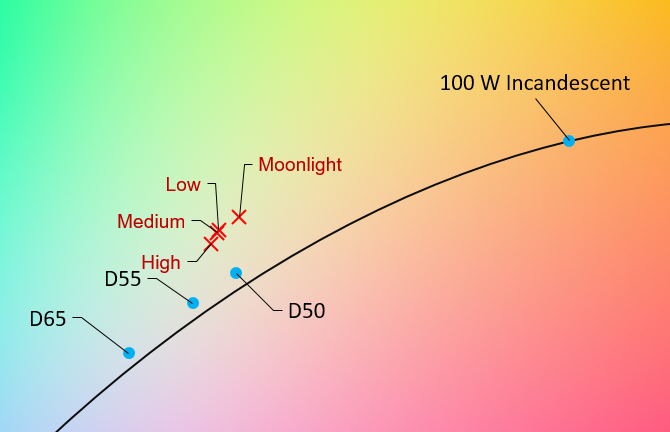
Tint in different brightness modes is quite consistent.
PWM
There is no PWM or pulsing on any mode.
Runtime (Turbo and High)
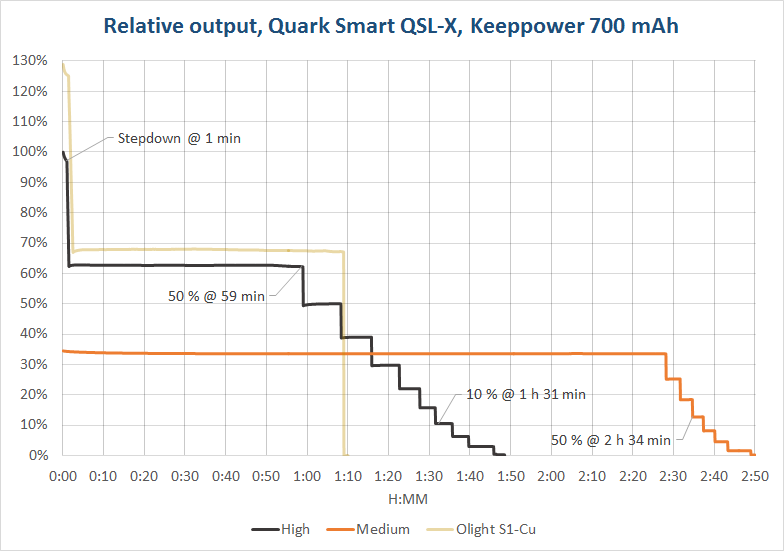
Runtime is typical for a Cree XM-L2 + RCR123 combination, which is also used in the Olight S1.
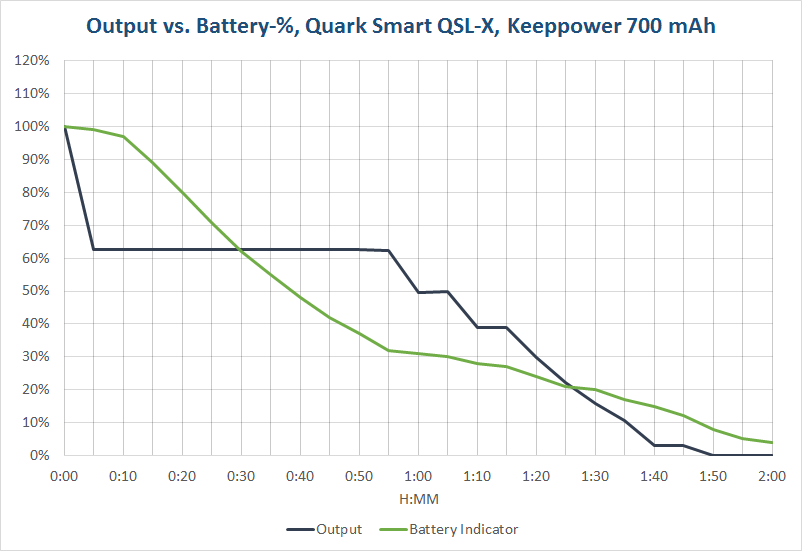
The smart battery indicator works well in heavy use. The reading only updates when the light is switched off. Please note that in reality the output stepdowns are immediate (see above runtime chart), but the 5 minute resolution does not show it.
Temperature and regulation
Heat is not a problem with the QSL-X. Even on high, the handle never gets very warm to hold.
Pros/Cons
+ No PWM/Pulsing
+ Output exceeds specification
+ Stable output regulation
+ Bluetooth range
+ Pro Interface mode is wonderfully versatile
- CRI way below what was promised (66 vs. 85)
- No comprehensive documentation for the versatile UI
- No programming of modes and outputs via the app
- No Android app yet
- No pocket clip
- Tailcap switch too finicky about the length of the battery
- Switching between Tactical and Pro modes possible only from the app (at the moment Android users need a loaner phone)
- Blue cast on the anti reflective coating

The Foursevens Quark Smart QSL-X is the world's first smartphone controlled flashlight. It houses a CR123A/RCR123 battery and an interesting software programmable double switch system.

* Battery type: CR123A/RCR123/16340
* LED: Cree XM-L2
* Color temperature: Not specified
* Body material: Type-III hard-anodized aircraft-grade aluminum
* Reflector: Orange peel
* Lens: Glass, sapphire coaring, anti reflective
* Waterproof: Not specified
* Impact resistance: Not specified
* Switch type: Side and tailcap
* Battery protection: Reverse polarity
* Regulation: Output regulation
* Tail stand: Yes
* Tripod threads: No
* USB rechargeable: No
* Controllable via Bluetooth 4.0LE from an iOS device (Android coming later)
* Length: 89,3 mm
* Width: 22 mm
* Head width: 23,1
* Weight: 42 g
* Output levels: 4
* Mode memory: Yes, programmable
* Button lock: No
* Direct access from off: Any mode with the smartphone app, strobe, moonlight, high
Special modes:
* Strobe (10 Hz)
* SOS
* Beacon Hi (1 sec momentary every 10 seconds)
* Beacon Lo (lower level 1 sec momentary every 10 seconds)



Included in the package
* Foursevens Quark Smart QSL flashlight
* CR123A battery
* Lanyard
* Keychain carabiner + ring
* Spare o-ring
* Holster
* Rubber finger-grip
* Operation guide



16340/RCR123A battery, Foursevens Quark Smart QSL-X, Olight S10, Astrolux S1 (18350), DQG Tiny 18650 4.
Bluetooth and smart features (will be updated when the app is patched)

The distinctive feature of the Quark Smart series is the ability to control them via bluetooth. The bluetooth 4.0 low energy protocol has a miniscule current draw and doesn't affect the battery life at all in practice.
There's a lot of potential with the technology, but most of it is unrealized at the time of writing this. Some promised features are still missing, such as the remaining time indicator or timer mode where you tell the light how long it has to stay on and it automatically adjust the output level to match. These are coming though, as soon as Apple store verification process is finished.
Currently the only reasons to use the smart features are checking the battery level, changing the UI mode (Tactical/Pro), remotely powering the light up and checking the last known location if you have lost the light. The temperature indicator is only in Fahrenheit and seems to seldom update itself. Even after shutting off the light, the temperature indicator stayed at 118°F for many minutes. Maximum temp I measured from the head was 42°C (108°F).
I would also like to see unlimited mode programming features. Being able to program any number of modes with infinitely adjustable output levels straight from your phone and then saving presets of those would be great. Some other useful possibilities would be setting the double click from off shortcut to any desired mode (currently strobe) or swapping the functionality of the switches or disabling either switch completely.
Tactical and Pro modes
The Quark Smart QSL-X has two modes that make the flashlight act differently to button presses. The switch between these two modes requires the use of the smart app. Since Android is not supported yet, users of Android phones have to loan an iPhone or request the Pro mode be activated when ordering. The Tactical mode is active by default.
In tactical mode, the tailcap switch acts only as a momentary switch. Keep it pressed and it activates the last used mode. The light remembers the last mode (also special modes) with the siwde switch and the momentary tailcap switch. In pro mode, the light always starts on low and the tailcap switch activates high. To activate high from off double click and hold the side switch.
In the first retail lights, there is a problem where a short click is probably required to be too short. When you want to return to the last active mode from off, the click has to be very fast. A normal lazy press will almost certainly start the light on moonlight.
This affects other UI features too. After choosing a suitable output level first by holding the side switch from off and then double clicking the light does not always advance to the next brightness level but to the previous. Following double clicks then just cycle between these two modes or sometimes advance to the next mode. All of this depends on the speed of the clicks you do during the double clicking.
In the Pro Interface mode there is no mode memory, unless you turn the light back on after only a second or two. Both switches latch on: a single click turns the light on and off. Double click (both switches) or long press on the side switch cycles modes. Double click and hold from off cycles modes backwards.
Long press on the tailcap switch activates momentary high. After releasing the button it returns to the previous mode. Long press of the tailcap switch in off activates momentary high and turns the light off after releasing. Double click from off activates strobe.
All in all, the UI is complicated even when not using the smart phone app. The fact that there is no comprehensive manual for features, you have to go searching forum threads for info. This light is not meant for your average joe. There should be at least an electronic and always up to date manual inside the app.
The functionality of the tailcap switch is heavily affected by the battery size. If the length is not exactly right, some features will be buggy or not work at all. The tailcap switch on my sample didn't work with the supplied CR123A primary. It was probably just a bit too short, because it only worked when pressed forcefully. With a Keeppower 16340 I had to open the tailcap one turn, since it is longer than a regular CR123A.
The UI is complicated and you should watch David Chow's good videos on how the tactical and professional modes work. After some use, the Pro Interface will probably grow on you.
Measurements
Please note: lumen measurements are only rough estimates
My diy 30 cm integrating styrofoam sphere has been calibrated using a Fenix E05 on high with manufacturer's claim of 85 lumens. Verified with an Olight S10 that has been measured with a Labsphere FS2 integrating sphere by valostore.fi. Results may be more inaccurate with especially throwy or floody lights.
For spectral information and CRI calculations I have an X-rite i1Pro spectrophotometer with HCFR for the plot and ArgyllCMS spotread.exe for the data. For runtime tests I use spotread.exe with a custom script and a i1Display Pro because it doesn't require calibration every 30 minutes like the i1Pro.
Explanation of abbreviations
CCT = correlated color temperature, higher temperature means cooler (bluish)
CRI (Ra) = color rendering index consisting of 8 different colors (R1-R8), max value 100
CRI (R9) = color rendering index with deep red, usually difficult for led based light sources, max value 100
TLCI = television lighting consistency index, max value 100
CQS (Qa) = Proposed replacement for CRI, RMS average of 15 color samples
CRI2012 (Ra,2012) = Another proposed replacement for CRI, consists of 17 color samples
MCRI = Color rendering index based on the memory of colors or 9 familiar objects
x,y = coordinates on a CIE 1931 chart

The lumen output exceeds the manufacturer's specification of 350 lumens. Low is off by a factor of 2,6 and medium is 29 % higher. Moonlight however is spot on.

Color rendering is a big disappointment. There's no mention of color temperature or CRI on the manufacturer's website, but the rep here on CPF promised an led with a CRI of 85. This is not the case, as you can see. This is your typical Cree XM-L2 with green tint and CRI in the 60s. CRI(R9) is the worst I've measured from a flashlight at -50.
Spectral distribution (High)

Color rendering (High)


Beam and tint

Beam has a hotspot angle of 17° and spill of 69°.

Average spill brightness is 5 % of the hotspot.

The tint has a clear but linear shift on different areas of the beam.

Tint in different brightness modes is quite consistent.
PWM
There is no PWM or pulsing on any mode.
Runtime (Turbo and High)

Runtime is typical for a Cree XM-L2 + RCR123 combination, which is also used in the Olight S1.

The smart battery indicator works well in heavy use. The reading only updates when the light is switched off. Please note that in reality the output stepdowns are immediate (see above runtime chart), but the 5 minute resolution does not show it.
Temperature and regulation
Heat is not a problem with the QSL-X. Even on high, the handle never gets very warm to hold.
Pros/Cons
+ No PWM/Pulsing
+ Output exceeds specification
+ Stable output regulation
+ Bluetooth range
+ Pro Interface mode is wonderfully versatile
- CRI way below what was promised (66 vs. 85)
- No comprehensive documentation for the versatile UI
- No programming of modes and outputs via the app
- No Android app yet
- No pocket clip
- Tailcap switch too finicky about the length of the battery
- Switching between Tactical and Pro modes possible only from the app (at the moment Android users need a loaner phone)
- Blue cast on the anti reflective coating
Last edited:


